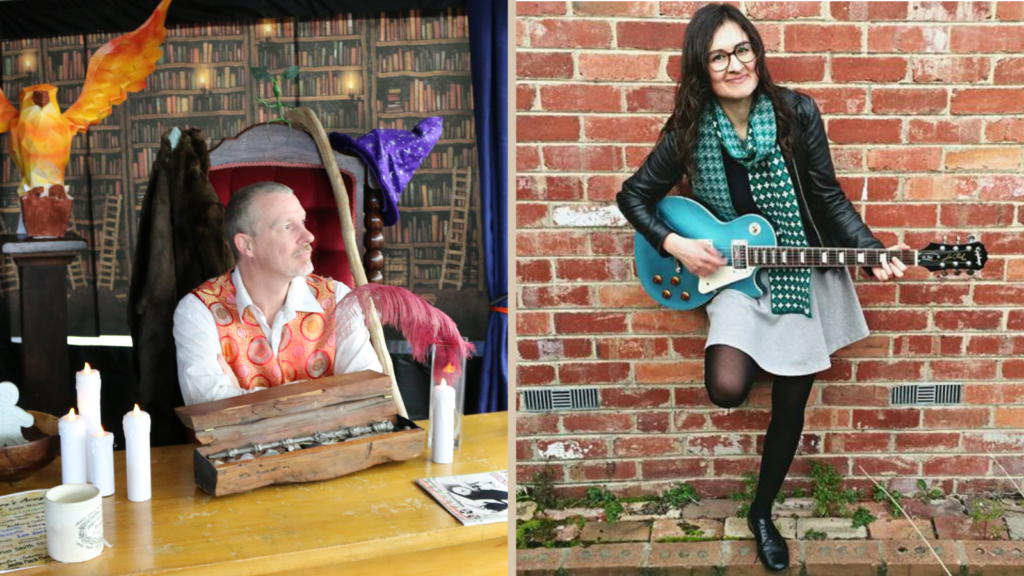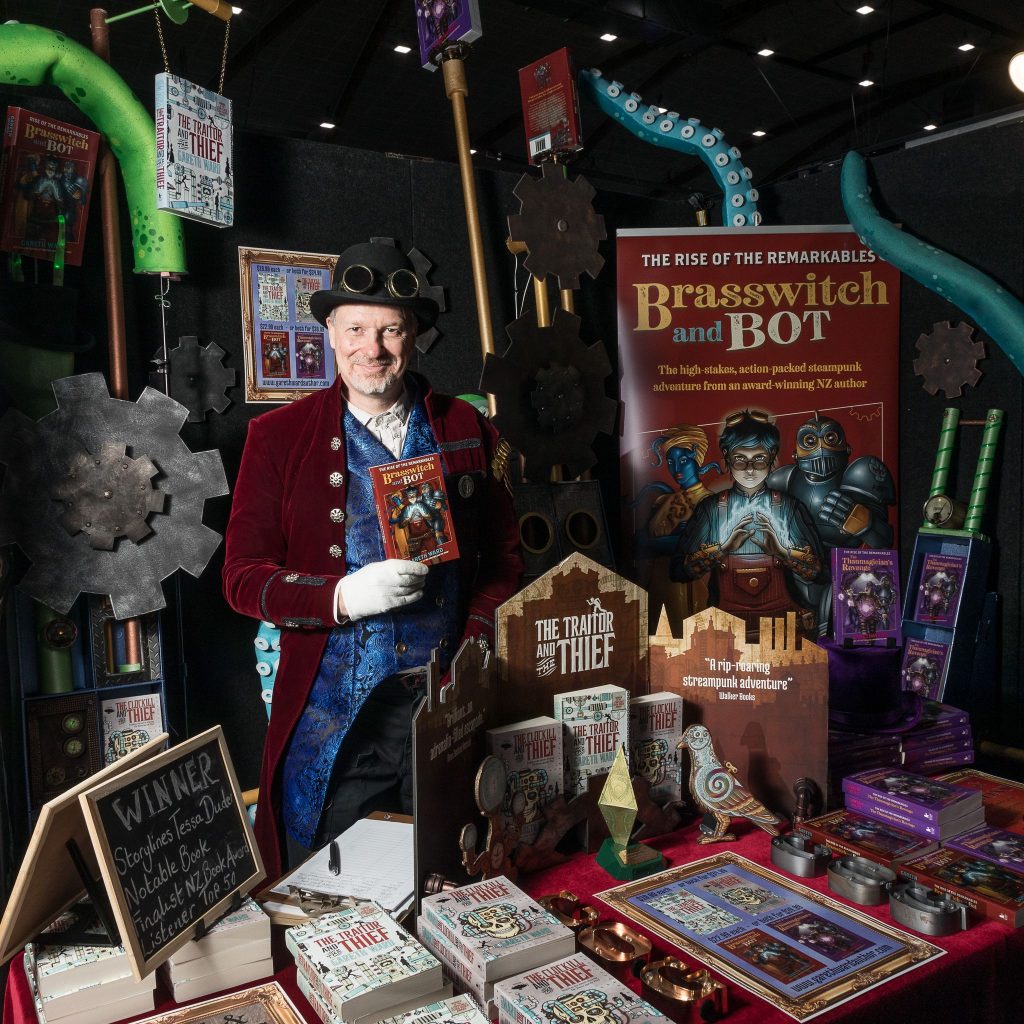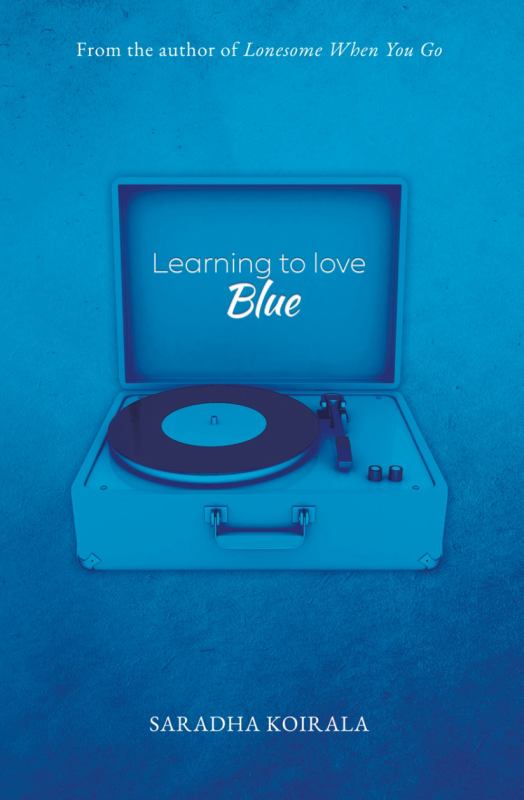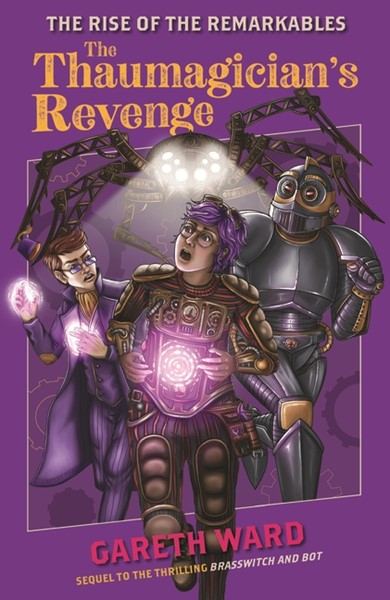Saradha Koirala and Gareth Ward recently wrote sequels to YA books. While it was Gareth’s second time writing a sequel, it was Saradha’s first, so we thought we’d get them to have a talk about how you know your story needs to continue, and how you write the next logical step.

Saradha Koirala: So lovely to ‘meet’ you albeit via email. I have just finished reading your duology and am eager to hear more! I loved the detailed Steampunk world where everything is always moving and hissing and spluttering along – I think there’s one quiet moment where Wrench is lying on her bed thinking about everything, but other than that it’s go go go! There’s so much messiness and smell and explosion, but also a lot of calculated precision in the machinery and gadgets and magic. I loved Wrench too and I have a strong suspicion that we haven’t seen the last of her.
Gareth Ward: Nice to e-meet you too. I’ve enjoyed reading your novels. Young Paige reminded me a bit of my daughter, not that she was ever in a band, although she did dabble at playing bass and tended towards punk. We like to feel that we appropriately educated and corrupted her with our music tastes.
Paige is very real to me, so I’m glad to hear she feels real to readers too!
We’ve both just had sequels published, and I was wondering, at what point did you know The Rise of the Remarkables was a series and not just one big book—and how on earth did you plan such an epic adventure story?
In my heart I always knew that Wrench and Bot had more story to tell than could be done justice in a single book. Fortunately, my publisher, Walker Books Australia, agreed to a duology, so I was able to plan in advance for two books, not that I’m a huge plotter. I tend to know the main story arcs, turning points and the ending of my novels but then just see where the story takes me. And if it strays away from my original idea, I’m happy to go with it. My brain seems to be good at making connections so as I write the plot strands seem to weave together.
In my heart I always knew that Wrench and Bot had more story to tell than could be done justice in a single book.
My sequel, The Thaumagician’s Revenge, takes place only a few weeks after the events of Brasswitch and Bot and so Wrench has changed little in that time.
In your sequel, Learning to Love Blue, Paige is, I’m guessing, three years older. She has gone from mid-teen to a proper young adult and has grown so much in that time. Did that make her harder to write? Did it cause any problems?
I think this was quite tricky to get right. When writing young Paige’s character for Lonesome When You Go, I was channeling my teenage self a bit, but also teaching teenagers and spending a lot of time in the high school setting, so I felt I had a good handle on the preoccupations of that age group. Once Paige leaves high school she also leaves home and leaves the country all at the same time, so it’s a completely different world. I wanted her to still be a bit naive and full of lofty ambitions, but she’s also very brave and sure of herself.
I wanted her to still be a bit naive and full of lofty ambitions, but she’s also very brave and sure of herself.
My first draft of Learning to love Blue had Paige a little too wise and self-reflective, lots of lying on her bed staring at the ceiling thinking about her feelings! It didn’t make for very good reading, but was perhaps more my experience of moving countries. I reigned a lot of that in and instead tried to have her interactions with people highlight the gaps in her understanding of relationships and the adult world.

There are really just a few hints about what happened in the years between the novels, but we assume she learnt a bit more about herself through playing with the older guys in Mudwiggle, her mum’s visit, being at home without her big sister… But she’d never had to worry about flatmates or paying rent or having enough money to survive before. She has quite a few small-town moments too, even though she comes from Wellington, which when you live there feels like a big city.
Wrench is also a brave and straight-talking young woman. At the beginning of Brasswitch and Bot she’s working at the coachworks and her obsession with machinery reminded me a bit of Paige’s obsession with music. I loved the development of the dynamic between Wrench and clanking, unsubtle Bot. Can you explain a bit about these characters and how they became your protagonists?
I loved the development of the dynamic between Wrench and clanking, unsubtle Bot.
I started writing Brasswitch and Bot just after Donald Trump had been elected and it pained me to see the hatred and prejudice that he was fostering. So, although at one level the novels are about a girl with superpowers and a kick-ass robot, the core of the story is about countering prejudice. To that end I knew that Wrench had to be someone who would stick up for herself and who would do the right thing no matter how hard or dangerous that was. She is tough, obstinate and bloody minded but also cares deeply about others. People that know me well have suggested she is based on my wife Louise—I couldn’t possibly comment on that.
Bot’s origins are simpler. He is based on a character from an unpublished Sci-Fi novel I wrote many years ago. I loved the character so much I knew he had to have an audience one day and this is his chance to shine. I find him interesting because he strives to protect the country and to do that, he has to make hard decisions and do questionable things.
I knew that Wrench had to be someone who would stick up for herself and who would do the right thing no matter how hard or dangerous that was…
The epilogue of Lonesome When You Go hinted at the possibility of a sequel. Was it always your intention to carry on with Paige’s story and was she always going to travel to Australia?
I hadn’t thought about a sequel until a very nice review of Lonesome suggested a sequel would be welcome. I always felt the end of Lonesome When You Go was quite satisfying and the epilogue was my way of letting Paige go on and live her life beyond the book. When I moved to Melbourne I had lots of ideas and a few false starts about what I wanted to write next, but I found Paige was still there in my head—her voice and determination—and I wanted to see what she would get up to next. I had her move to Melbourne because it can be a bit of a rite of passage for musicians and it really is a great place to play gigs. I was spending a lot of time with musicians too and just kept thinking ‘Paige would love this!’

Do you think travelling across the ditch offered opportunities for character development that staying in New Zealand wouldn’t have?
I think moving to Australia meant Paige really was out of her comfort zone. On the surface, it’s a very easy migration from New Zealand to Australia, but in reality there are all sorts of weird differences over here and the sheer scale of a big big city… I still haven’t really got my head around how big this place is. So, as long as Paige was confident and sure of herself and playing music with the big kids, I couldn’t see a lot of character development happening for her. Popping her on a plane and sending her somewhere that feels familiar, but is actually nothing like the cosy easiness of high school and home town, seemed like a good challenge. She has to make new friends and learn how to play and work and live with other people. I’m kind of proud of her for being so brave, but then she hadn’t really realised how brave that move was going to be.
Popping her on a plane and sending her somewhere that feels familiar, but is actually nothing like the cosy easiness of high school and home town, seemed like a good challenge.
In your novels the Steampunk setting is full of very different weird quirks and gizmos. Your duology is very visual and dynamic—how do you make sure the mechanics of your creations are in working order and consistent from one novel to the next? I’m imagining a writing space filled with train sets and gadgets and noise!
My writing space is mostly filled with magic tricks, effects and props, which cater to my alter-ego of magician The Great Wardini. I do have a cabinet of Steampunk paraphernalia but that is elsewhere in the house. I think quite deeply about the gadgets and technology in my world and where possible like to give them a grounding in science, even if I then go on to stretch the reality of what might actually be possible. Keeping consistency across novels was mostly a case of carefully re-reading Brasswitch and Bot and making notes. The bigger problem was making sure nothing sneaked in from The Traitor and the Thief and The Clockill and the Thief which is my other series.
The bigger problem was making sure nothing sneaked in from The Traitor and the Thief and The Clockill and the Thief which is my other series.
With Paige being a bass player, a key strand of your novels are Paige’s trials and tribulations in various bands and the gigging music industry. Are you musical and do Paige’s experiences mirror of your own experiences?
During high school I played violin and double bass in orchestras and chamber music groups. We actually competed in chamber music competitions, which is a bit of a strange concept. Then I played bass guitar in a high school band for Smokefree Rockquest ’96! And a couple of other bands at uni and beyond.
During high school I played violin and double bass in orchestras and chamber music groups. We actually competed in chamber music competitions, which is a bit of a strange concept.
So, I do have a small amount of experience playing gigs and arguing in practice rooms, but the last band I played in was years ago in my first year of teaching. We used the band room at Wellington High School and I based the band room at Paige’s school in Lonesome When You Go on that room. I actually had Wellington High School band, Vertigo, play at the launch of Lonesome When You Go—it was like having my characters on stage! These days I still play violin very occasionally and play the guitar mostly for my daughter. Five Little Monkeys is a crowd-pleaser, but I’m always sure to slip in some Dylan and Joni Mitchell too.







